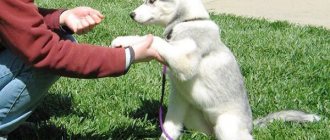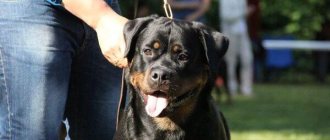In this article you will learn about breed standards and temperamental characteristics of Dobermans. Find out what he likes and what he doesn't.
We will also cover the issue of the normal ratio of weight and height , and the factors that violate this ratio. In addition, we will tell you how a puppy should grow and develop.
Character and intelligence of Dobermans
The Doberman Pinscher is a service dog that retains protective qualities. At the same time, representatives of the breed should not show aggression towards humans and other animals for no reason. Dobermans are fearless and loyal - they are unlikely to leave their owner for a treat or a toy.
Dogs of this breed are very active and energetic, requiring appropriate physical activity. Animals are easy to train: Dobermans are very smart and quick-witted. In addition, pets are well-oriented and always ready to interact with their owner. As a rule, animals behave calmly at home, without imposing unnecessary attention on family members.
Caring for animals is easy. Dobermans are very friendly and welcoming. Of course, there are exceptions in the breed, but in most cases the angry, aggressive or fearful character is reinforced by the owner himself due to his illiteracy and lack of experience.
How to weigh correctly?
- The easiest way is to weigh yourself, and then pick up the dog and weigh yourself again. The difference in weight will be the weight of the pet.
- The second way is to attract attention with a treat, holding it over the scales; as a rule, dogs, when they see food, sit motionless.
- Dynamometric scales (usually these are used to weigh bags of vegetables at the market) - put overalls on the dog, attach a scale to the top and pull until the pet lifts off the ground.
Where to begin
Training a pet must begin with building a relationship with the owner and establishing motivation. To improve your bond with your animal, play with him more and have fun together. When a Doberman trusts the trainer, the work process begins to lead you to a positive result.
Do not scold your pet when he makes a mistake, but use positive reinforcement (treats or toys) to explain to him an alternative correct behavior.
How to motivate a Doberman to train?
- Offer food that is more palatable for your pet as a treat. For example, meat or offal;
- Don't just feed your dog. The dog must earn a bowl of food. Before feeding the animal, ask it to follow several commands or use the food as a reward for a full training session;
- start the lesson only when the Doberman is not full and full of energy. A well-fed and tired animal will not want to work. Moreover, with tedious activities you will only take away the dog’s desire to work;
- exercise often, but not for long. Short approaches will prevent the dog from feeling bored and tired;
- Praise your pet more often. Remember that emotionality also has a positive effect. Deliver your praise in a cheerful, cheerful, and energetic manner.
Vaccinations
In addition to regular care, the animal needs protection from infectious diseases. When picking up a pet at the age of 1–1.5 months, you should also take a certificate of vaccinations. This period can be slightly extended - if the puppy is fed mother’s milk for a long time, then it will receive important trace elements and antibodies and, as a result, immunity along with food.
General vaccination plan:
- 7–8 weeks: vaccination against distemper, parvovirus, adenovirus, parainfluenza type 2 and canine leptospirosis;
- 12–13 weeks: revaccination against distemper, parvovirus, adenovirus, parainfluenza type 2 and canine leptospirosis + rabies vaccination.
At the age of three months, Doberman puppies and some other breeds change their teeth; vaccinations are prohibited at this time .
After a year, re-vaccination is carried out, then the animal should be vaccinated once a year.
The vaccination schedule for a particular animal is selected depending on the state of health, living conditions and heredity; for this, you should obtain a recommendation from a veterinarian. If vaccines from a foreign manufacturer are used, it is advisable to choose one manufacturer in order to ensure the most optimal vaccination schedule with drugs that correspond to each other.
IMPORTANT! Foreign-made veterinary drugs imported into Russia must be registered by the Department of Veterinary Medicine of the Ministry of Agriculture and have a document confirming that they have passed repeated Russian quality control at the VGNKI of veterinary drugs.
When to start training and education?
As soon as the puppy arrives to you, after a couple of days, when he gets used to the new environment, you can already begin the first stages of training. Classes should be simple and take place in a playful way. The puppy does not need to be scolded or punished - this will only worsen your relationship with him. Training should be fun for both the puppy and you.
Proper care for Dobermann puppies
To properly care for Doberman puppies, try to take the summer litter out into the yard as often as possible so that the puppies can be in the sun and have plenty of play in the fresh air. This is usually done when they are four and a half weeks old, taking into account the weather so that they do not freeze. Crop their ears at six to seven weeks of age. From birth, puppies must be kept clean - this is an immutable and, perhaps, the most important condition when raising them. If you don't stick to it, you'll end up creating a lot of problems for yourself, for the puppies, and for their new owners. Puppies, accustomed from birth to cleanliness in the birth box, will be easy to teach to recover on the street; they are less susceptible to helminthic infestation, because you promptly examined them for the presence of worm eggs and carried out preventive deworming. It makes no sense to keep puppies clean if the territory and walking areas of the kennel are contaminated with endoparasites. Preventative deworming of roundworms should be carried out on four-week-old puppies, because if at least one of them has Toxocara eggs, it can infect all the others. If they do not have worms, then after ear cropping you need to examine their feces for the presence of worm eggs. Before selling puppies, their feces must be examined again.
Clean, wash and sanitize enclosures as often as possible, especially inside (you should do this daily).
Before ear cropping, the litter should be divided into groups (no more than four puppies). It is necessary to collect them in a pen only during playtime - they need communication with peers and active physical exercise. The composition of the group is not constant, change it every time so that especially active puppies cannot offend anyone. You need to sell your pets at the age of 9-10 weeks.
A huge role in raising puppies is played by the experience of the breeder, who must know and take into account all stages of their development.
Selecting a location
The first stages of Doberman training should take place in a calm and familiar place. A house or apartment is an ideal area for training, because it is there that the animal will not be distracted by extraneous stimuli.
If the Doberman already has some skills and interacts well with the owner, training can be carried out on the street. Of course, you shouldn’t immediately start studying in noisy and crowded places. Start working in a peaceful and quiet environment, gradually moving to places where there are more and more stimuli.
Choice of treats
The selection of treats is individual for each dog. You will have to experiment and offer the animal different variations of treats: meat and offal, cottage cheese, specialized dog treats, cheese (not recommended in large quantities).
As a rule, dogs prefer meat products most of all. Meat and offal can be given raw or cooked - at your discretion. It is more convenient to work with a boiled treat, but a raw treat will bring more vitamins to the animal’s body.
Dogs are still predators, and they are adapted to digest raw foods (perhaps with rare individual exceptions). The main thing is to buy quality products from trusted places.
The more smell the treat has, the more interested your pet will be in it. Choose a more fragrant type of meat or offal (not to be confused with rotten). In order to enhance the effect, you can cook the meat in water to which garlic has been added. After cooking, be sure to remove the garlic if it gets into pieces of meat. Such a treat is safe and more interesting for the animal due to the enhanced pungent odor.
Height at withers after one year
For males - 68-72 cm, for females - 63-68 cm. Medium-sized dogs are much more common than large ones. Males weigh 40-45 kg, females - 32-35 kg. The shape of the dog is more reminiscent of a square than an oval: the length of the body usually does not exceed the height at the withers by more than 5% in males. So, normal height to weight ratios are:
- male 66-72, weight 35-45 kg;
- female 61-68, weight 25-40 kg.
Important! These data are averaged and standardized for common climatic and regional conditions. If your dog leads an active lifestyle and plays sports, then his weight can be either more due to muscle mass or less due to a decrease in body fat.
Also, if a dog has more calcium in its diet, its height and weight will be higher due to bone mass.
Basic commands in training
Basic skills include exercises that will be applicable in everyday life and will make your walks with your pet safer.
To me
Since the Doberman requires serious exercise, it will be easier to provide him with activity without a leash (of course, in areas that allow such walks). In order for a walk without a leash to be safe, you need to teach your dog the “come to me” command. Be sure to take treats with you when walking so that you can reward your animal for approaching you every time.
Stand
An important command for safe walks. It can be used in any emergency situations when you need to stop the dog or, for example, when simply crossing the road (stopping in front of a pedestrian crossing).
Ugh
On the street and at home, there are harmful or completely inedible foods for dogs to eat. Often, pets are interested in forbidden things and strive to eat them. The “fu” command will prevent an unpleasant action and save your animal from disappointing consequences in the form of health problems.
Sit
The “sit” command will make your life with your pet more comfortable. There are situations when you need to sit your dog down. For example, in front of a door to open it and calmly move on. The command is completely easy to train and does not require much strength or patience from the trainer.
Photos of what newborns look like
Newborn Doberman puppies are born completely helpless, blind and deaf . Newborn Dobermans have no teeth and do not know how to regulate body heat.
The first two weeks after birth, the puppy's needs are very limited - food, sleep and warmth. Previously, during this period, puppies' ears and tails were docked, but now they often do not dock them.
Newborn puppies have an elastic, dense body, large paws and heads.
At one month the puppy's weight is already 3.5-4 kg, body length 22-27 cm.
OKD – general training course
Receiving the OKD standard will indicate that your dog has been trained in basic training skills and is well-mannered and safe for others. To pass the test, you must attend training courses or prepare yourself.
The OKD standard is not mandatory for execution. If the owner is interested in passing the OKD or any training organizations require a certificate of passing this standard, it is necessary to pass the test. Training and compliance with the OKD standard is a simple process, since the criteria are quite simple and loyal to more serious sports.
ZKS - protective guard service
Training in defense is a more serious process than passing the OKD standard. Classes must be conducted with a canine handler. Otherwise, you will turn your dog into an aggressive and uncontrollable animal. ZKS requires a competent and responsible approach to business.
The dog is taught guard qualities, protection, control, and attentive listening to the owner. A properly trained defense dog can save you from intruders. In addition, training in ZKS skills makes the animal much more resilient and confident.
Socialization
It is necessary to socialize your pet from puppyhood. Show your puppy as many different places and objects as possible. Walk in noisy and crowded places to accustom your Doberman to society.
Ask passers-by and friends to come up and pet your puppy and give him treats so that he is not afraid of strangers. Do not exclude meeting other dogs - the pet must be able to communicate with its relatives.
If possible, travel with your dog on public transport, starting with short routes. Show your animal the whole diverse world around him. The more your dog knows and sees, the more confident he will feel on walks.
What to feed
Portions when using dry and semi-dry food are calculated according to the weight and age of the puppy, starting from three months. At first, dry food is first soaked in boiling water. Ready-made food is convenient because it is initially balanced and takes into account the needs of the dog’s body.
The diet when eating natural products should include meat, fish, vegetables, cereals and vitamin and mineral supplements; milk and dairy products are required for up to ten months. You should follow the breeder's instructions and general recommendations for feeding puppies, observing and adjusting the feeding pattern in accordance with the health requirements and tastes of the pet itself.
IMPORTANT! You should not pay special attention to cheap feeds; they are not recommended for regular use.
Basics and stages of raising a puppy
2 months
At this age, it is important to teach the Doberman not so much commands as certain basic skills: following a hand with a treat, games, paying attention to the owner, eye contact. You can use treats to guide your puppy into the sit, down, and stay positions without using voice commands.
As for the educational process, you can show the puppy that there is no need to bite or jump on the owner. If the puppy bites you, pretend that you are hurt and go into another room. When the dog jumps on you, turn away from him and wait for him to sit down.
At this age, it is necessary to accustom the puppy to go to the toilet in a diaper, since quarantine is observed, and going outside is unsafe for health.
3 months
At the age of 3 months, you can gradually move on to learning simple commands and educational tricks. The tricks should be simple so as not to harm the animal: twisting around its axis, walking in a “snake” and “figure eight” between the legs, bowing, walking backwards.
Tricks are needed to physically develop the Doberman. With the help of such exercises, the dog learns balance, feeling his body and each limb separately. Well-developed coordination reduces the risk of injury while walking.
4-5 months
At the age of 4 months, you can gradually move on to activities outside, in the yard. Teach your puppy not to be distracted by others, but to stay focused on you. It is important to teach this skill to your pet so that it does not run away from you in the future.
Also, continue to study simple commands and developmental tricks. Train your puppy to use the toilet outside, gradually eliminating diapers from the house. Slowly teach your pet to stay home alone: first leave for 10 minutes, gradually increasing the time.
6 months
Teach your puppy more serious skills and commands: endurance, walking nearby, following commands from a distance. Of course, it is important to take into account that the pet is still a puppy - there is no need to demand execution of commands according to inflated criteria.
At what age do you start training?
Puppy training must begin from the very first days
the presence of a dog in your home. Because already from infancy, the puppy must learn the rules of behavior in your house, what is allowed and what is forbidden, how to behave with all family members, even the smallest and oldest, what he can play with and what he can’t, where to go. toilet and much more.
And we are talking, first of all, about the proper upbringing of a Doberman puppy, and you can start training and learning commands when the puppy is completely comfortable in your home. As a rule, one week is enough. By this time, the puppy is already filled with curiosity and is diligently exploring the world around him. If, after this time, the puppy remains fearful and does not make contact well, then it is better to seek help from a dog handler-animal psychologist, because This behavior is not typical for puppies of this breed.
When can you start training with a dog handler?
The beginning of the puppy's training coincides with the time of the first exit to the street. When the first two vaccinations have already been done, the quarantine (lasts 7-14 days, depending on the vaccination) after them is over. It is not at all necessary to train your puppy only outside; the first sessions are best done at home, where there are fewer distractions.
Often new puppy owners worry that training from the first days will be excessively stressful for the dog. This is only possible if outdated, rigid methods are used, and with the right approach, training from the first days will, on the contrary, be very useful, since it allows you to immediately establish contact
with the puppy and build a trusting relationship.
You can start raising a puppy from the first days of its appearance in your home, and training and classes with a dog handler can begin simultaneously with the start of walks, when quarantine ends after the second vaccination.
Why you don't need to wait up to 6 months
You often hear that Dobermans, like other dogs, cannot be trained before 6 months, because training is stressful. This opinion remains from the times of outdated methods based on cruel coercion and intimidation of the dog. Unfortunately, there are still plenty of dog handlers using similar techniques today. But fortunately, science does not stand still and modern techniques make it possible to train a puppy from the first days in a new home. Therefore, you should not wait until your Doberman puppy has established unwanted behavior; you can start training much earlier.
Raising an adult dog
If the moment of raising a Doberman is missed during puppyhood, it will be more difficult to correct the behavior of an adult dog, since it already has certain habits.
Raising an adult dog requires persistence and patience. Of course, you should not yell at your pet or use violence. It is necessary to find an approach that will be applicable specifically to your dog: some need a tougher and stricter owner, while others, on the contrary, need a soft and calm one. Training is carried out individually in connection with the qualities, abilities and character of a particular dog.
What is the best food to feed a Doberman female after giving birth?
What to feed a Doberman after giving birth is not an idle question. The higher the quality of mother's milk, the easier it is for all “interested parties,” so the bitch should be allowed to eat whatever she wants, as long as the food does not weaken her.
After the diet, the bitches now begin to produce milk 45 days after mating and continue to produce milk until the puppies are weaned. This diet does not require any vitamins or mineral supplements.
Below is a description of what food to feed your Doberman after giving birth to ensure excellent milk quality.
Morning: two cups of high-quality food, a pound of ground beef or lean cuts, vitamins and calcium (as prescribed by veterinarian).
Day: half a kilo of cottage cheese with two soft-boiled eggs or “in a bag”, you can add canned food.
Afternoon snack: repeat the morning feeding, but give canned or boneless chicken meat, and a little liver a couple of times a week (to awaken the dog’s appetite, if it is reduced or absent).
Late evening: a cup of milk. If your dog loves dairy products, it is better to feed the Doberman with dry food soaked in milk in the morning, rather than water.
Reward and Punishment
To achieve success in training and education, it is necessary to reward the animal and, in some cases, apply punishment.
Types of incentives:
- Reward with a treat. The most common way of praise among dog lovers. In this way, the Doberman can be quickly and clearly praised for the correct action.
- Game encouragement. There are play dogs who prefer play to treats or who love everything. Praising a dog with a toy is more difficult and takes longer than with food, but if the Doberman prefers this kind of encouragement, then the results will only be achieved with the help of it.
- Encouragement with attention from the owner. Dobermans need emotional praise from their owner. In some cases, attention is even more important for pets than a treat or toy.
What are the punishments?
Violent punishment should not be used against animals. In some cases, raising the tone is allowed, but only when you are sure that the dog understands why you are punishing him. As a rule, the most effective method of punishment is ignoring.
For example, if a Doberman starts jumping on you and tearing your clothes, ignore, turn around and walk away - in the future the dog will seek attention from you in more humane ways.
Table for a puppy by month (with growth)
| 1 month | The weight of a newborn Doberman is from 450 to 650 g. This depends on genetic predisposition, the number of puppies born, and sexual characteristics. Females are generally smaller than males. During the first month of life, a Doberman puppy rapidly gains weight. His daily weight gain can be about 80 grams, after 30 days he will already weigh 3.3 kg. up to 4kg. Its height at the withers can reach 22-28 cm. |
| 2 month | Over the next month, the Doberman doubles its weight, and by the end of the second month this figure will be 8-9 kg. He can already feed himself and on average gains 150 grams per day. |
| 3 month | By 3 months of age, puppies are usually transported to new owners. At this point, the weight is already 12.3 - 14 kg. The height at the withers of Dobermans is from 38 to 44 cm. |
| 4 month | By the fourth month, the process of weight gain slows down. The dog begins to grow upward faster, and the weight can range from 16 to 19 kg. |
| 5 month | Upon reaching the age of five months, the puppy is already considered a teenager, growing mainly in length. His chest muscles begin to develop. During this month, Dobermans weigh from 20 kg. up to 23.5 kg. |
| 6 month | The six-month-old Doberman baby is still actively gaining weight, which ranges from 22 to 24 kg. Height at this moment is from 64 to 69 cm. |
| 7 month | In the seventh month, the Doberman gains muscle mass even more slowly and looks like an adult dog. Its weight is 24-28 kg, and its growth rate also slows down. The height at the withers can be about 74 cm. |
| 8 month | Doberman Pinschers at 8 months of age are still gaining a small amount of weight, although they are already reaching the size of an adult. The weight of the pet varies from 26 to 30 kg. They are slowly increasing their height, which is already 70-75 cm. |
| 10 month | The ten-month-old individual finally reaches its full-size dimensions, namely: weight within the range of 25-31 kg. Its height at the withers is from 70 to 75 cm. |
| 12 month | We are now one year old. Now the Doberman is a fully grown animal that weighs 30-36 kg. Height at the withers is within 80 cm. |
Further, he will increase weight due to muscle mass, and height will increase due to the growth of bones in thickness by several millimeters per year.
Important! If the puppy deviates significantly in weight from the table, it is necessary to undergo veterinary diagnostics. At an early age, all genetic or pathological problems can be easily and quickly ruled out.
Briefly about the main thing
- Dobermans are guard dogs that are friendly and loyal to their owners.
- Dogs of this breed are well-oriented and easy to train.
- You can train a Doberman from the age when he came to you and got used to it.
- Choose a quiet place to practice.
- Choose the most delicious treat
- Start your workouts with short sets, doing simple exercises.
- Increase the duration and complexity of training as your puppy ages.
- If you wish, you can take training more seriously by passing the OKD and ZKS tests.
- Try to train your Doberman on positive reinforcement with treats, toys and emotional praise.
Teaching Doberman basic commands
Doberman training at home should be approached very responsibly. Young dogs learn quickly, but with insufficient physical and mental stress, errors in upbringing and training, they can become uncontrollable, show aggression, and sometimes even bitterness.
The optimal time to start training is considered to be 8-12 weeks. The first training lessons should last no more than 10 minutes, regularly.
Basic commands that a Doberman must be taught in the first year of life:
- "Place!". One of the very first commands that a puppy learns. Disciplines the pet and helps control its movements.
- "To me!". It induces in the dog the skill of reliably approaching the owner upon command or gesture.
- "Ugh!". A prohibiting command prevents attempts to show interest in unwanted objects.
- "Near!".
- “Sit!”, “Stand!”, “Lie down!” A set of commands that keep the dog in a certain position.
- “Aport!” The skill of lifting and carrying an object.
Useful skills that will simplify the training process:
- calm attitude towards the muzzle;
- neutral attitude towards spilled food or treats offered from a stranger;
- calm reaction to loud sound;
- ability to overcome mechanical obstacles: stairs, barriers, boom.
Before starting the training course, the owner must ensure that the following auxiliary details are available:
- leash 5-8 meters long;
- short leash, 1-2 meters;
- mat (practice “Place!”);
- the object being imported (for example, a toy);
- reward item (treat, toy).











